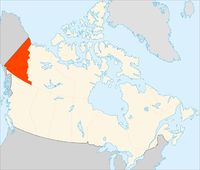Yukon Territory 63° 0' 0.53" N, 136° 0' 9.01" W List Group
Based on the 2006 Canadian Census, of the 30,190 individuals living in the Yukon Territory, 1,220 identify as visual minorities. The cultural breakdown of this demographic is as follows:
- Chinese: 325
- Filipino: 210
- South Asian: 195
- Southeast Asian: 145
- Black: 125
- Latin American: 100
- Japanese: 40
- Multiple visible minority: 40
- Arab: 20
- Visible minority, n.i.e.: 15
- West Asian: 10
- Korean: 10
The Early Years
Man in Chair
YA, E.J. Hamacher fonds, 78/28 #114
On June 2, 1898, a gold-seeker with the name of Tanaka, from Yokohama, Japan, was recorded by the North West Mounted Police (NWMP) as he crossed the Chilkoot Pass. By 1901 an official count showed 84 Japanese, 7 Chinese, and no “Hindu” in the Yukon. Demographic records, especially from the early 20th century, often grouped all people of Asian ancestry together, without indicating where they were from, or used terms like “Hindoos” which are open to misinterpretation. Asian people faced both social and legal discrimination, in the Yukon and across the country. The Chinese Immigration Act of 1885 charged each Chinese immigrant a “capitation tax” or “head tax.” In 1908 the Hayashi-Lemieux “Gentleman’s Agreement” between the Japanese and Canadian governments severely restricted the number of Japanese immigrants.
For many years, Asians — along with women and aboriginal people — were also prohibited from voting. Despite this prejudice and inequality the Asian residents of the Yukon established themselves as miners, labourers, household servants, sternwheeler crew members, entrepreneurs and even special constables for the NWMP. The Royal Commission on Dr. Thompson’s veranda
The Royal Commission on Dr. Thompson’s veranda, Dawson City, August 1903; Asian servant in background.
YA, J.B. Tyrrell fonds, 82/15 #290 RCMP Letter
YA, GOV 1681 f.31 Yukon Population by Ethnic Group
Yukon Population by Ethnic Group, 1901-1961 — For many years Japanese people in the Yukon outnumbered people of Chinese ancestry, although the numbers for both groups were small.
YA, Pamphlet 1961-0058 Staff of the Canadian Bank of Commerce
The staff of the Canadian Bank of Commerce in Dawson, n.d.
YA, Myron Burr fonds, 90/24 #12 Semi-Weekly Star (Whitehorse)
Semi-Weekly Star (Whitehorse), June 28, 1902 McDonald’s section-gang
McDonald’s section-gang, White Pass and Yukon Route, Carcross, ca. 1905.
YA, John Scott fonds, 89/31 #186 Child at a vegetable stand
A child at a vegetable stand in Dawson City, August 28, 1906.
YA, J.B. Tyrrell fonds, 82/15 #404 Conrad Mines crew
Conrad Mines crew with cook, 1906.
YA, J.B. Tyrrell fonds, 82/15 #488 Two women
Margaret & Rolf Hougen Coll., 2002/188 #526 Masayuki Sakata Massa Sakata
Massa Sakata (centre) with Allan John “Hard Rock” McDonald (left) and another man, Keno City, 1955.
YA, Yukon Asian History Collection, 2006/146 #9
Masayuki Sakata was born in Japan in about 1889 and arrived in Dawson City with his parents on April 15, 1907. He became a well-known entrepreneur, operating restaurants in Dawson, Mayo and Keno. He also set up a lunch program for Dawson school children. In the 1930s he worked for the Treadwell Yukon Company Ltd. at their silver mines on Keno Hill; in later years he ran the Rex Cafe in Dawson and the Sourdough Cafe in Keno. On December 11, 1969 he became a member of the Yukon Order of Pioneers. He died in Whitehorse on April 22, 1974. Massa Sakata
Massa Sakata in Mayo, 1937.
YA, Yukon Asian History Collection, 2006/146 #18
